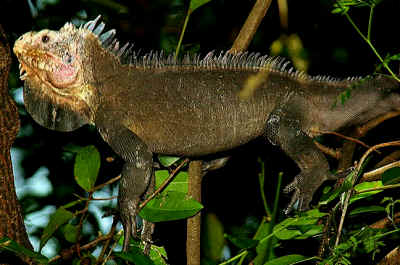 Iguania: Iguanas, chameleons, and their relatives
Iguania: Iguanas, chameleons, and their relatives| Squamata | ||
| The Vertebrates | Iguania |
| Vertebrates Home | Vertebrate | Vertebrate |
|
Abbreviated Dendrogram
Lepidosauromorpha
├─Sphenodontia
└─Squamata
├─Iguanomorpha
│ ├─Hoyalacerta
│ └─Iguania
│ ├─Tropiduridae
│ ├─Acrodonta
│ │ ├─Priscagamidae
│ │ └─┬─Agamidae
│ │ │ ├─Amphibolurinae
│ │ │ └─Draconinae
│ │ └─Chamaeleonidae
│ └─Iguanidae
└─Scleroglossa
|
Contents
Overview |
Definition: All taxa sharing a more recent common ancestor with Iguana iguana than with Gekko gecko, Scincus scincus, or Varanus varius. Conrad, 2008 p.73
Range:from the Early Cretaceous.
Squamata :Huehuecuetzpalli + (Scincogekkonomorpha + * : Hoyalacerta + Iguania).
Note: Sukhanov (1961) coined the terms Iguanomorpha and Scincogekkonomorpha to refer to the two fundamental groups of iguana-like lizards and all other squamates. These terms were then adopted in a cladistic context by Conrad, 2008, who lists two unambiguous synapomorphies and whose definition is followed here. The interpretation of some other previously defined basal Iguanians is less clear. Euposaurus, previously considered a basal iguanian, is now known to be a chimera of an undetermined squamate and a sphenodontian. The Gondwnan taxa Tikiguania (late Triassic) and Bharatagama (Early Jurassic) are poorly known forms that may be basal Iguanomorphs, basal Squamata, or even for that matter basal Lepidosaurs. However Arretosaurus, another basal form, seems to be chamaeleontiform (Conrad, 2008 p.91) and hence is nested in the Acrodonta. MAK101106
Hoyalacerta: Hoyalacerta sanzi Evans & Barbadillo, 1999
Early Cretaceous (Barremian) of Las Hoyas assemblage, Spain
Iguanomorpha :Iguania + *
Comments: A very basal form, despite its relatively late occurance, placed on the squamate stem by Evans 2003 but relocated to the Iguanian stem by Conrad, 2008 and Evans & Wang 2010 MAK101106
 Iguania: Iguanas, chameleons, and their relatives
Iguania: Iguanas, chameleons, and their relatives
from the Late Cretaceous.
Iguanomorpha :Hoyalacerta + * : Tropiduridae + Acrodonta + Iguanidae.
Skull tall; temporal arch is present; fleshy tongue; teeth pleurodont or acrodont; $ frontals fused; $parietal foramen on frontal - parietal suture; eyelids well developed; pupils round; most have dorsal crest and extensible dewlap; often ornamented with crests, spines, frills, and throat fans; six cervical vertebrae; usually robust bodies, short necks, distinct heads; breaking-point septa present in caudals and some forms have rather fragile tails; overlapping non-iridescent scales; four or more transverse belly scales per body segment; frequently brightly colored. Smaller, insectivorous forms primitive, but larger herbivores where less competition, including marine forms. Largely ambush predators; diurnal; either arboreal, terrestrial or semi-marine.
Links: Higher Reptile Taxa (EMBL database); Iguania; herplab9.pdf; herplab3.pdf; Eric Pianka's Ctenotus Research; home2; Iguanidae; Foraging and Trophic Ecology; Iguania Best on the Web).
The ToL page still has only a vague polyotomy for a cladogram, and a list of references a decade old. As for the cladogram, perhaps that's all there is. Mikko's Phylogeny has the same, but Mikko includes some more recent references. ADW has some really excellent material on the individual families, but nothing worth visiting at this level. The EMBL site is its usual authoritative and encyclopedic self, but is really designed for use at the genus level and below. Even the Swiss-Prot folks have shown only limited interest in the gene sequences of this taxon. Fortunately, true afficionados of lizard phylogeny on the web may consult Frost et al. (2001). This is one of the combined morphological - molecular studies the AMNH has pioneered in recent years. Other articles of interest include Delheusy & Bels (1999) on iguanid feeding kinematics. The only pages we located with a list of shared characters are brief lists on a VMNH page, a lab manual from the University of Texas and Anthony Herrel's site at the University of Antwerp. However, we have saved the best for last: Vitt & Pianka (2005) combine squamate ecological and phylogenetic data to create a really convincing explanation of the phylogeny based on diversification of feeding strategies. ATW
 Tropiduridae: Leiocephalus, Liolemus, Microlophus, Stenocercus, Tropidurus (= Plica?)
Tropiduridae: Leiocephalus, Liolemus, Microlophus, Stenocercus, Tropidurus (= Plica?)
Range:South America, Indonesia.
Characters: small- to moderate-sized; distinct head and neck; $angular reduced; splenial extended posteriorly; teeth pleurodont; tails typically at least as long as body; body scales usually coarse ("spiny"); sternum with posterior extension with enlarged, median fontanelle; limbs & digits well developed; some have tail spines, dorsal crests or similar ornamentation; color typically cryptic; most insectivores or omnivores; diurnal; males may exhibit territorial and sexual displays involving stereotypic head and body movements.
Links:Amphibians and Reptiles checklist - Project Amazonas field sites in the Peruvian Amazon; Tropiduridae Best on the Web); A SEMI-ANNOTATED BIBLIOGRAPHY AND TAXONOMY OF THE; Animal Diversity Web: Tropiduridae: Information.
Image:Tropidurus itambere. Photo by Prof. Guarino R Colli. ATW040220.
Iguania: Tropiuridae + Acrodonta + *.
Range:Maastrichtian to Recent of North and South America, Madagascar, and some Pacific islands.
Characters: tongues short & barely protrusible; pleurodont dentition; tail usually longer than body; well-developed limbs; fourth toe nearly twice as long as fifth; most have long tails, crest, and dewlaps; head covered with larger scales or plates; belly scales small, in several rows, or not obviously in longitudinal series; belly scales pointed or rounded, but not quadrangular; males are bright and varied in coloring; desert & forest dwellers mainly herbivores, while smaller iguanidae insectivores or omnivores.
Comments: small to large lizards, terrestrial or semi-aquatic herbivores, long-legged, swift running, some have scaly crest along the back. Teeth on the inner side of the jaws.
Links:Animal Diversity Web: Family Iguanidae; Iguanidae; Iguanidae; Die Iguanidae-Webseite; Iguanas; Iguanidae.html.
Note: Probably polyphyletic group with numerous families. ATW060219
checked ATW050806